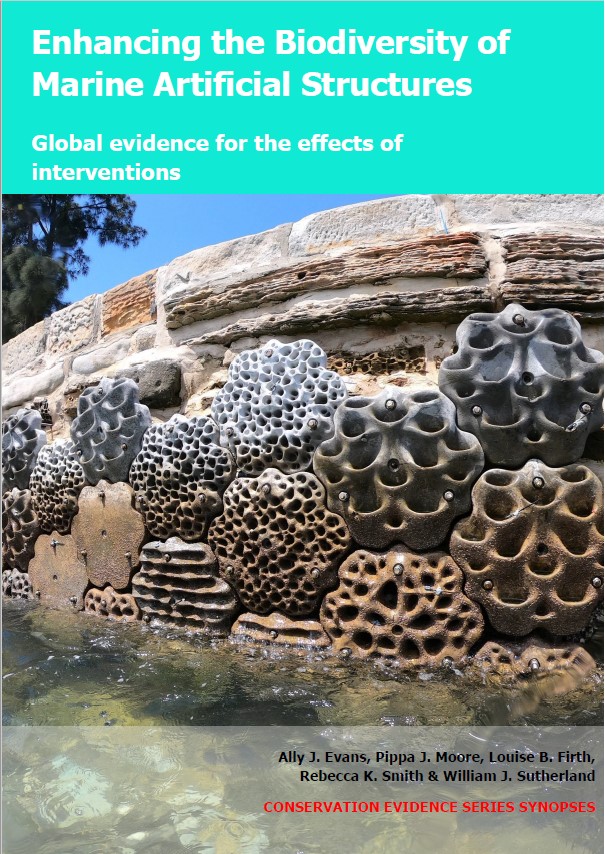Create small protrusions (1–50 mm) on intertidal artificial structures
-
Overall effectiveness category Awaiting assessment
-
Number of studies: 2
View assessment score
Hide assessment score
How is the evidence assessed?
-
Effectiveness
not assessed -
Certainty
not assessed -
Harms
not assessed
Study locations
Supporting evidence from individual studies
A replicated, randomized, controlled study in 2009–2010 on two intertidal seawalls on island coastlines in the Singapore Strait, Singapore (Loke & Todd 2016a; same experimental set-up as Loke & Todd 2016b) found that concrete settlement plates with small protrusions supported higher macroalgae and invertebrate species richness but similar community composition and abundances compared with granite plates without protrusions. After 13 months, macroalgae and invertebrate species richness was higher on settlement plates with small protrusions (8 species/plate) than without (3/plate), while abundances were statistically similar (88 vs 178 individuals/plate). Community composition was similar on plates with and without protrusions (data reported as statistical model results). Settlement plates (200 × 200 mm) were moulded with and without small protrusions. Plates with protrusions were concrete with 36 cylindrical protrusions/plate with either regular (16 mm width, height and spacing) or variable (4–28 mm) arrangement. Plates without protrusions were granite fragments set in cement. Granite may be considered an environmentally-sensitive material compared with concrete (see “Use environmentally-sensitive material on intertidal artificial structures”). Eight of each design were randomly-arranged at both lowshore and highshore on each of two granite boulder seawalls in November–December 2009. Macroalgae on plates were counted from photographs and invertebrates in the laboratory after 13 months.
Study and other actions testedA replicated, randomized, controlled study in 2009–2010 on two intertidal seawalls on island coastlines in the Singapore Strait, Singapore (Loke & Todd 2016b; same experimental set-up as Loke & Todd 2016a) found that concrete settlement plates with small protrusions, along with grooves, small ridges and pits, supported higher macroalgae and invertebrate species richness than granite plates without added habitats, but that abundances and community composition varied depending on the habitat arrangement, shore level and site. After 13 months, macroalgae and invertebrate species richness was higher on settlement plates with protrusions, grooves, ridges and pits than without at lowshore (13–23 vs 6–10 species/plate) and highshore (5–9 vs 2–3/plate). Richness was higher on plates with variable habitats than regular ones at lowshore (22–23 vs 13–16/plate), but not highshore (6–9 vs 5–6/plate). Abundances were higher on plates with added habitats than without in four of eight comparisons (9–833 vs 3–208 individuals/plate), while community composition differed in three of four comparisons (data reported as statistical model results). In all other comparisons, results were similar (abundances: 104–1,957 vs 49–1,162/plate). It is not clear whether these effects were the direct result of creating protrusions, grooves, ridges or pits. However, plate quarters with protrusions had similar richness (8 species/quarter) and abundances (88 individuals/quarter) to quarters with the other habitat types (6–11 species and 97–231 individuals/quarter). Settlement plates (400 × 400 mm) were moulded with and without small protrusions, along with grooves, small ridges and pits. Plates with added habitats were concrete. Each 200 × 200 mm quarter contained either 36 cylindrical protrusions, four-to-five grooves and ridges, 12 ridges or 36 pits. All habitats had either regular (16 mm width, depth/height and spacing) or variable (4–28 mm) arrangement. Plates without added habitats were granite fragments set in cement. Granite may be considered an environmentally-sensitive material compared with concrete (see “Use environmentally-sensitive material on intertidal artificial structures”). Eight of each design were randomly arranged at both lowshore and highshore on each of two granite boulder seawalls in November–December 2009. Macroalgae on plates were counted from photographs and invertebrates in the laboratory after 13 months.
Study and other actions tested
Where has this evidence come from?
List of journals searched by synopsis
All the journals searched for all synopses
This Action forms part of the Action Synopsis:
Biodiversity of Marine Artificial Structures
Biodiversity of Marine Artificial Structures - Published 2021
Enhancing biodiversity of marine artificial structures synopsis





)_2023.JPG)














